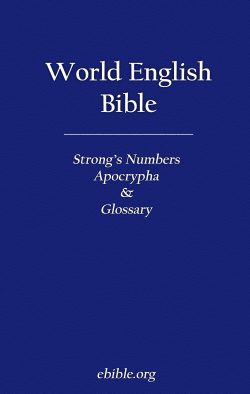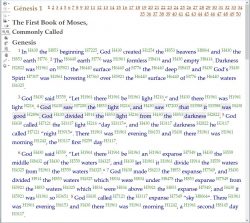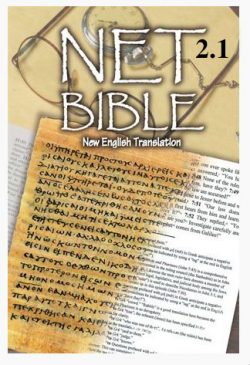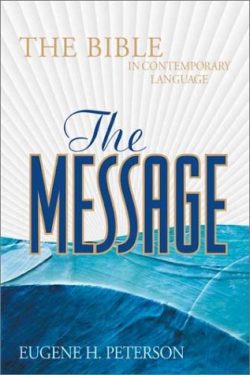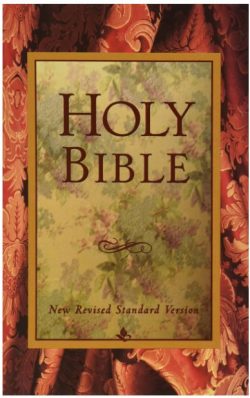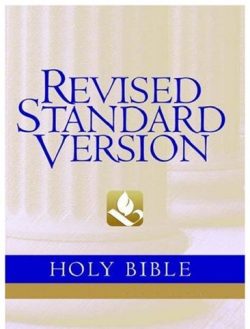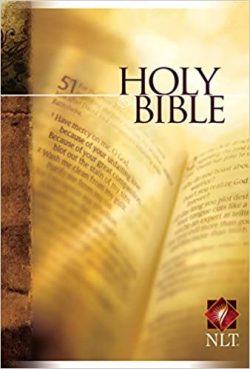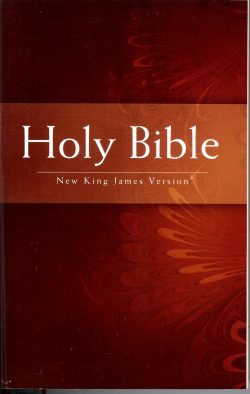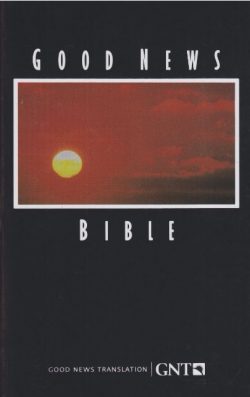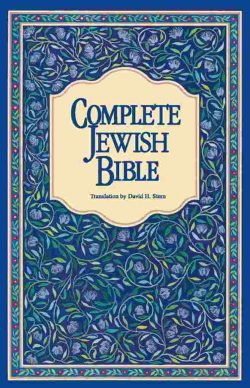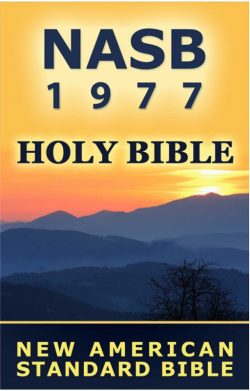World English Bible (Strong’s Numbers, Glossary & Apocrypha)
Description:
Why was the World English Bible translated?
There are already many good translations of the Holy Bible into contemporary English. Unfortunately, almost all of them are restricted by copyright and copyright holder policy. This restricts publication and republication of God’s Word in many ways, such as in downloadable files on the Internet, use of extensive quotations in books, etc. The World English Bible was commissioned by God in response to prayer about this subject.
Because the World English Bible is in the Public Domain (not copyrighted), it can be freely copied, distributed, and redistributed without any payment of royalties. You don’t even have to ask permission to do so. You may publish the whole World English Bible in book form, bind it in leather and sell it. You may incorporate it into your Bible study software. You may make and distribute audio recordings of it. You may broadcast it. All you have to do is maintain the integrity of God’s Word before God, and reserve the name “World English Bible” for faithful copies of this translation.
How was the World English Bible translated?
The World English Bible is an update of the American Standard Version (ASV) of the Holy Bible, published in 1901. A custom computer program updated the archaic words and word forms to contemporary equivalents, and then a team of volunteers proofread and updated the grammar. The New Testament was updated to conform to the Majority Text reconstruction of the original Greek manuscripts, thus taking advantage of the superior access to manuscripts that we have now compared to when the original ASV was translated.
What is different about the World English Bible?
The style of the World English Bible, while fairly literally translated, is in informal, spoken English. The World English Bible is designed to sound good and be accurate when read aloud. It is not formal in its language, just as the original Greek of the New Testament was not formal. The WEB uses contractions rather freely.
The World English Bible doesn’t capitalize pronouns pertaining to God. The original manuscripts made no such distinction. Hebrew has no such thing as upper and lower case, and the original Greek manuscripts were written in all upper case letters. Attempting to add in such a distinction raises some difficulties in translating dual-meaning Scriptures such as the coronation psalms.
The World English Bible main edition translates God’s Proper Name in the Old Testament as “Yahweh.” The Messianic Edition and the British Edition of the World English Bible translates the same name as “LORD” (all capital letters), or when used with “Lord” (mixed case, translated from “Adonai”,) GOD. There are solid translational arguments for both traditions.
Because World English Bible uses the Majority Text as the basis for the New Testament, you may notice the following differences in comparing the WEB to other translations:
The order of Matthew 23:13 and 14 is reversed in some translations.
Luke 17:36 and Acts 15:34, which are not found in the majority of the Greek Manuscripts (and are relegated to footnotes in the WEB) may be included in some other translations.
Romans 14:24-26 in the WEB may appear as Romans 16:25-27 in other translations.
1 John 5:7-8 contains an addition in some translations, including the KJV. Erasmus admitted adding this text to his published Greek New Testament, even though he could at first find no Greek manuscript support for it, because he was being pressured by men to do so, and because he didn’t see any doctrinal harm in it. Lots of things not written by John in this letter are true, but we decline to add them to what the Holy Spirit inspired through John.
With all of the above and some other places where lack of clarity in the original manuscripts has led to multiple possible readings, significant variants are listed in footnotes. The reading that in our prayerful judgment is best is in the main text. Overall, the World English Bible doesn’t differ very much from several other good contemporary English translations of the Holy Bible. The message of Salvation through Jesus Christ is still the same. The point of this translation was not to be very different (except for legal status), but to update the ASV for readability while retaining or improving the accuracy of that well-respected translation and retaining the public domain status of the ASV.
theWord Version includes Strong Numbers (Not on every word but many if not most.), Glossary Dictionary and Apocrypha
theWord Features
Bible
- Strong’s Numbers
- Headings
- Verse popups
- Cross References
- Fully searchable text
- Footnote(s)
- Easy navigation of topics via Bible tree or Verse Reference Entry
- Special Text Colors
- Normal: Text
- Greek: λογος
- Hebrew: א
Glossary
- Verse popups
- Fully searchable text
- Easy navigation of topics via topics tree display.
- Special Text Colors
- Normal: Text
- Hyperlink: Link | Jn 3:36
Apocrypha
Books included: Tobit, Judith, Esther (Greek*), Wisdom of Solomon, Sirach, Baruch, 1 Maccabees, 2 Maccabees, 1 Esdras, Prayer of Manasses, Psalms 151, 3 Maccabees, 2 Esdras, 4 Maccabees, Daniel (Greek*)
*Greek means they included portions translated from the Greek in addition to the Hebrew.
- Verse popups
- Fully searchable text
- Footnote(s)
- Easy navigation of topics via topics tree display.
- Special Text Colors
- Normal: Text
- Hyperlink: Link | Jn 3:36
- Hebrew: א
NET Bible, version 2.1, full notes edition
New separate commentary notes!
Version 2.1 Released!
The NET Bible is a powerful new translation of the Bible (having 58,504 translators’ notes by experts in the original biblical languages). When you combine theWord Bible software program with this Bible, you can easily see the translator’s many notes by simply mousing over the translator’s note’s number, and the actual text will pop up.
These translator’s notes are an excellent commentary for Bible students knowing Greek and Hebrew in that they point out the original words, how their underlying forms (grammatical structure) affects the translation of the verse. But at the same time, while this highly technical information is available for the experienced scholar, it is also very clear and understandable for the common Bible student as far as what it means. For example, the moods and tenses of Greek verbs often have comments when they reflect on the meaning of the text. This is very helpful and insightful to common Bible student.
This is an updated version 2 of this work. It also adds Strong’s numbers to the text.
IF UPGRADING FROM NET 1
Using NET2 Commentary Notes – notes are now available again as separate Commentary notes, and yet also remain in the footnotes as well.
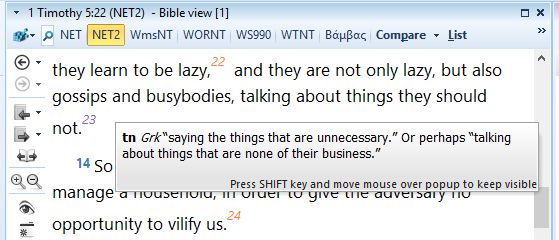
How to use NET2 footnotes, click in Bible, then press just “f” to toggle on and off, and then hover over the footnote you want to see.
The Message
PRODUCT HIGHLIGHTS:
- Includes passage headings, paragraph and poetry indentations, italic words
DESCRIPTION
Many people assume that a book about a holy God should sound elevated, stately, and ceremonial. If this is how you’ve always viewed the Bible, you’re about to make a surprising discovery. The Message brings the life-changing power of the New Testament, the vibrant passion of the Psalms, and the rich, practical wisdom of Proverbs into easy-to-read modern language that echoes the rhythm and idioms of the original Greek and Hebrew.Written in the same kind of language you’d use to talk with friends, write a letter, or discuss politics, The Message preserves the authentic, earthy flavor and the expressive character of the Bible’s best-loved books. Whether you’ve been reading the Bible for years or are exploring it for the first time, The Message will startle and surprise you. And it will allow you to experience firsthand the same power and directness that motivated its original readers to change the course of history so many centuries ago.
Eugene Peterson, translator and editor, set out to give us that word in language we use every day, a reading Bible that would enable the Word to penetrate our hearts and minds, transforming us day by day into the person God desires us to become. Features:
- Written in clear, direct language that brings the Bible to life
- Covers all 66 books of the Bible
- A paraphrase from the original Hebrew and Greek languages
New Revised Standard Version Bible
The New Revised Standard Version of the Bible (NRSV) was published in 1989. It’s goal was to appeal to all religions and religious groups. The translation committee was made up of thirty translators from every Protestant denomination, the Roman Catholic as well as Greek orthodox church, and a Jewish scholar as well. It typically comes in a version that includes the Apocrypha (but our version for theWord does not have the Apocrypha, but is the standard edition without the Deuterocanonical books).
Revised Standard Version Bible
The Revised Standard Version of the New Testament purported to be a revision of the American Standard Version. It is akin to Moffat’s Bible Translation in a lot of ways.
Copyright© 1946, 1952, and 1971 the Division of Christian Education of the National Council of the Churches of Christ in the United States of America
New Living Translation®, Second Edition (NLT)
The Holy Bible, New Living Translation provides a wonderful balance of readability and authority. It is easy to understand, poetically beautiful, powerful, and emotive. At the same time, due to the careful work of ninety leading Bible scholars, it is accurate to the original Greek and Hebrew text. The New Living Translation makes the Bible accessible, useful, and enjoyable for every situation. The easy-to-read, clear text is perfect for comparative study of difficult passages.
The New King James Bible (NKJV)
The New King James Version is a total update of the 1611 King James Version, also known as the “Authorized Version.” Every attempt has been made to maintain the beauty of the original version while updating the English grammar to contemporary style and usage. The result is much better “readability.” It is noteworthy that the NKJV is one of the few modern translations still based on the “Western” or “Byzantine” manuscript tradition. This makes the New King James Version an invaluable aid to comparative English Bible study.
Commissioned in 1975 by Thomas Nelson Publishers, 130 respected Bible scholars, church leaders, and lay Christians worked for seven years to create a completely modern edition of the King James Version that would continue the classic tradition of the original King James. With unyielding faithfulness to the original Greek, Hebrew, and Aramaic texts, the translators applied the most recent research in archaeology, linguistics, and textual studies. The resulting work provides today’s Bible reader with an accurate and modern translation of the Scriptures with the stylistic beauty and memorable quality of the King James.
Good News Translation in Today’s English Version with Apocrypha (GNT)
The GNT (also known as Today’s English Version or Good News Bible) was one of the first meaning-based (or functional equivalent) translations of the Bible into English. It was originally published in 1976, then it was revised in 1992. The GNT presents the message of the Bible in a level of English that is common to most of the English-speaking world. The GNT is still used widely in youth Bible study groups and in less formal worship services.
A very contemporary translation that is designed to be easy to read for those who are not familiar with the Bible. Also known as the Good News Bible, this translation of the Bible follows a dynamic equivalence theory of translation. Published in 1966, revised in 1992.
Complete Jewish Bible (CJB)
Presenting the Word of God as a unified Jewish book, the Complete Jewish Bible is a translation for Jews and non-Jews alike. It connects Jews with the Jewishness of the Messiah, and non-Jews with their Jewish roots. Names and key terms are returned to their original Hebrew and presented in easy-to-understand transliterations, enabling the reader to say them the way Yeshua (Jesus) did! For readers familiar with the Jewish New Testament, the Complete Jewish Bible is a welcome sight!
The CJB is a translation of the Bible into English by Dr. David H. Stern. It consists of Dr. Stern’s revised translation of the Old Testament (Tanakh) plus his original Jewish New Testament (B’rit Hadashah) translation in one volume. It was published in its entirety in 1998 by Jewish New Testament Publications, Inc.
The Old Testament translation is a paraphrase of the public domain 1917 Jewish Publication Society version. The New Testament section is Dr. Stern’s original translation from the ancient Greek.
Dr. Stern’s purpose for producing the Complete Jewish Bible was “to restore God’s Word to its original Jewish context and culture as well as be in easily read modern English.”
The CJB follows the order and the names of the Old Testament books in the Jewish Bible, rather than those of typical Christian Bibles. It uses Hebrew names for people and places, such as Eliyahu for “Elijah”, and Sha’ul for “Saul.” The work also incorporates Hebrew and Yiddish expressions, such as matzah for “unleavened bread” and mikveh for “ritual immersion pool”.
New American Standard Bible 1977 (NASB)
Since its completion in 1971, the New American Standard Bible has been widely embraced as “the most literally accurate English translation” from the original languages. Millions of people, students, scholars, pastors, missionaries, and laypersons alike, trust the NASB, learning from it and applying it to the challenges of their daily lives. Discover what the original text says, word for word.This is the original 1977 edition of the NASB. It includes italics for words which are not in the original, poetry styling and small caps, chapter headings, numerous translator’s notes (more than 17,000) and cross-references (more than 93,000).

